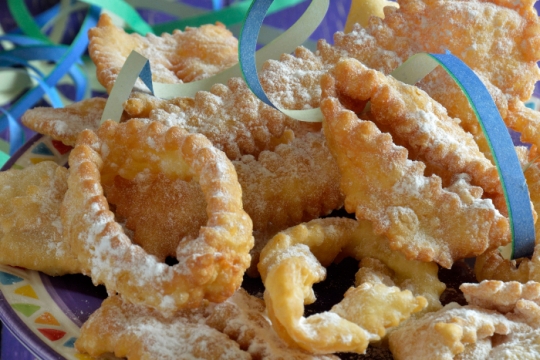This recipe is a variation of fried Italian dough, which was commonly prepared in Italian kitchens, but had no association with Purim. It is a perfect example of one ethnic holiday custom infiltrating general society. The Italian flavoring of choice was anisette, used in place of some of the brandy in this recipe. The addition of finely grated lemon zest is a more “Jewish” variation. In European countries, Purim pastries were often shaped like parts of Haman's body so that people could "eat him into oblivion."
Ingredients
2 cups all-purpose flour plus additional for rolling
2 tablespoons sugar
¼ teaspoon salt
½ teaspoon baking powder
Finely grated zest of ½ small lemon
1/3 cup milk
1 egg
1 egg yolk
2 tablespoons olive oil
2 tablespoons brandy
1 ½ teaspoons vanilla
Vegetable oil for frying
Confectioners' sugar
Directions
- Combine the first five ingredients in a mixing bowl. Set aside.
- Combine the remaining liquid ingredients for the dough in a small bowl and whisk together until well combined. Proceed immediately to add this mixture to the flour and stir by hand or machine until soft, slightly sticky dough is formed.
- Turn out dough onto a generously floured board and gently knead for 15 strokes to form a soft ball of dough. Cover with the inverted used mixing bowl and let the dough rest for ½ hour.
- Divide the dough in half and roll one half on a moderately floured board until it is very thin (1/16th inch) and almost transparent.
- Pour 3 inches of oil into a deep pot or fryer and heat to 375°F.
- Cut strips of dough that are about 4 inches in length by 1 inch. As you lift up each strip, the dough will stretch a little, which is OK. Bring the two ends of dough together and lightly press them to form a sagging O.
- Fry the dough 3 or 4 pieces at a time until golden. Drain on crumpled paper towels.
- When all the dough is fried, place on a serving tray and sprinkle liberally with confectioners' sugar while still warm. Serve.
Additional Notes
- Dough made with oil will always appear to be sticky, even when its consistency is correct. Use a little more flour than usual on your board when rolling out the dough to prevent it from sticking.
- It is important to keep the temperature of the frying oil consistent so that the dough does not get soggy. Never add too much food to the oil at once or the temperature will drop and change the quality of your finished product.
- Whenever a recipe calls for draining food on paper towels, always crumple the paper into loose galls first before putting them on a tray. The crumpling creates more surface area for the oil to be absorbed, resulting in less greasy foods and fewer used towels.
- Confectioners' sugar will adhere much better when it is sprinkled on food that is warm rather than cool.



